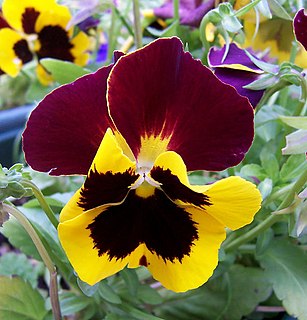
The garden pansy is a type of large-flowered hybrid plant cultivated as a garden flower. It is derived by hybridization from several species in the section Melanium of the genus Viola, particularly Viola tricolor, a wildflower of Europe and western Asia known as heartsease. Some of these hybrids are referred to as Viola × wittrockiana Gams ex Nauenb. & Buttler. For simplicity, the older name Viola tricolor var. hortensis is often used.
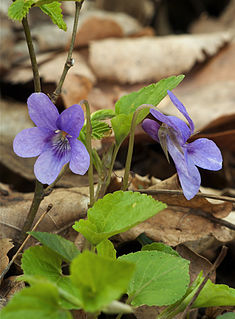
Viola is a genus of flowering plants in the violet family Violaceae. It is the largest genus in the family, containing between 525 and 600 species. Most species are found in the temperate Northern Hemisphere; however, some are also found in widely divergent areas such as Hawaii, Australasia, and the Andes.
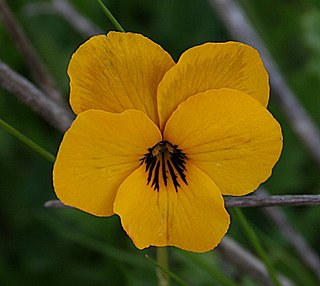
Viola pedunculata, the California golden violet, Johnny jump up, or yellow pansy, is a perennial yellow wildflower of the coast and coastal ranges in California and northwestern Baja California. The common name "Johnny jump up" is usually associated with Viola tricolor however, the introduced garden annual.

Viola odorata is a species of flowering plant in the viola family, native to Europe and Asia. This small hardy herbaceous perennial is commonly known as wood violet, sweet violet, English violet, common violet, florist's violet, or garden violet. It has been introduced into North America and Australia.

The pearl-bordered fritillary is a butterfly of the family Nymphalidae found in Europe and through Russia across the Palearctic to the north of Kazakhstan.

Viola lutea, also known as the mountain pansy, is a species of violet that grows in Europe, from the British Isles to the Balkans.
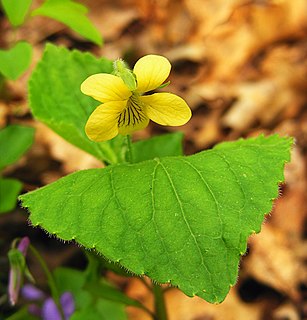
Viola pubescens, commonly called the downy yellow violet, is a plant species of the genus Viola and is classified within the subsection Nudicaules of section Chamaemelanium. It is a widespread North American violet found in rich, mesic woodlands, and sometimes in meadows, from Minnesota and Ontario east to Nova Scotia and south to Virginia. V. pubescens produces two different types of flowers during the season, including chasmogamous flowers in the early spring and cleistogamous flowers summer through fall.

Viola canadensis is more commonly known as Canadian white violet, Canada violet, tall white violet, or white violet. It is widespread across much of Canada and the United States, from Alaska to Newfoundland, south as far as Georgia and Arizona.

Viola sororia, known commonly as the common blue violet, is a short-stemmed herbaceous perennial plant that is native to eastern North America. It is known by a number of common names, including common meadow violet, purple violet, woolly blue violet, hooded violet, and wood violet. Its cultivar 'Albiflora' has gained the Royal Horticultural Society's Award of Garden Merit.
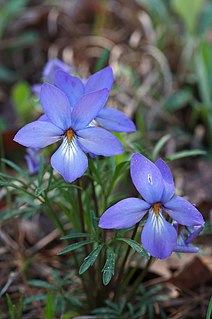
Viola pedata, the birdsfoot violet, bird's-foot violet, or mountain pansy, is a violet native to sandy areas in central and eastern North America.

Viola beckwithii, known commonly as the Great Basin violet, Beckwith's violet, and sagebrush pansy, is a species of violet native to the western United States. It is an early-flowering plant of sagebrush habitats in the Great Basin region.
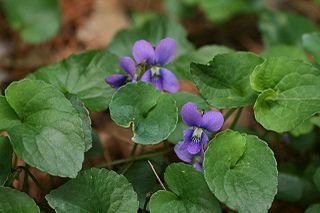
Viola cucullata, the hooded blue violet, marsh blue violet or purple violet, is a species of the genus Viola native to eastern North America, from Newfoundland west to Ontario and Minnesota, and south to Georgia. It is a recipient of the Royal Horticultural Society's Award of Garden Merit.

Viola purpurea is a species of violet which bears yellow flowers. It is known commonly as the goosefoot violet. It is a small plant which bears thick to fleshy toothed or ridged oval leaves which are mostly green but may have a purplish tint to them. The flowers are made up of bright yellow petals, the lowermost being streaked or veined with purple and the lateral petals with purplish undersides.

Viola glabella, the stream violet or pioneer violet, is usually found along streams or in moist woods in northeastern Asia and northwestern North America.
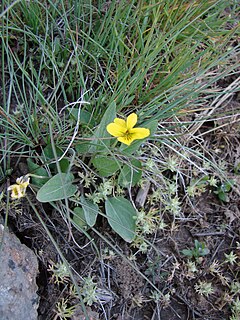
Viola nuttallii is a perennial herbaceous plant in the violet family (Violaceae), and is one of the few violet species with lanceolate leaves. It is native to the western Canada and the north-central and western United States.

Viola praemorsa is a species of violet known by the common names canary violet, Astoria violet, and yellow montane violet.
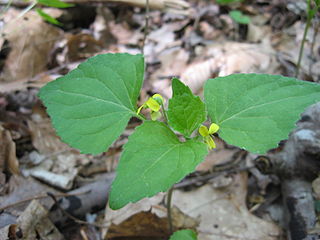
Viola tripartita is a species of violet known by the common name threepart violet. It is native to Eastern North America, being primarily found in the Southern Appalachian Mountains. Its preferred habitat is rich, mesic forests over calcareous rocks. It is a small perennial herb that has yellow flowers in the spring. It is distinguished from other caulescent yellow violets native to the area by having leaves that are wider than long which have a cuneate base.

















